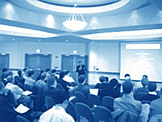
If you are having trouble reading the monthly report, please click
here.
![]()
![]()
Target Corporation Joins Auto-ID Center
In January Target
Corporation joined the Auto-ID Center's Board of Overseers. Target
Corp. is engaged in general merchandise retailing. The Company's store
brands include Target, Marshall Field's and Mervyn's. The Company operates
978 Target locations, 267 Mervyn's locations, and 64 department store
locations throughout the U.S. In early 2000 target.direct, the direct
merchandising and electronic retailing organization of Target Corporation,
was formed. Target Corporation also owns Associated Merchandising Corporation
(AMC), which sources the high quality apparel and hardlines merchandise
for the company.
![]()
Symbol Technologies, Inc. joins Technology Board In January
Symbol Technologies
joined the Auto-ID Center Technology Board. Symbol Technologies, Inc.
develops, manufactures, sells and services scanner-integrated mobile and
wireless information management systems that consist of mobile computing
devices, wireless local area networks (WLAN), bar code reading devices,
network appliance devices, peripheral devices, software and programming
tools. The Company's systems are designed to provide solutions to customer-specific
needs in information transactions. They are used in a variety of applications,
from collecting information at remote locations and transmitting information
between these locations and the user's central data processing facility,
to facilitating e-commerce transactions by accessing and collecting price
and product information at the point of activity for storing or placing
orders via the Internet. Several Symbol devices also connect wirelessly
to WANs.
 |
Next
Auto-ID Academic Alliance Planned Building on the success of the first Alliance meeting, the Auto-ID Academic Alliance will continue to broaden its connections to RFID research and academic institutions worldwide. Meetings will be held three times a year, with global diversity in the location of each meeting. The next meeting will take place late in the spring. For more information contact Karen Sherriff |
View the meeting minutes and presentation from the December 10, 2001 meeting.


EPC Alliance Europe Scheduled for March
The EPC Alliance is made up of nonprofit trade body organizations with
10 members or more. The Alliance works as a committee, looking at the
applications of the EPC for their specific constituency. Members include
such diverse groups as retail, food marketing, grocery manufacturers,
chain drug stores, convenience stores, textile services, healthcare and
transportation.
"I am proud and honored to be associated with the Auto-ID Center's project as the co-chair of its EPC Alliance group. The EPC Alliance Europe brings a global perspective to the project that will ensure the technology meets industry standards in the U.S and worldwide", states Joy Nicholas, Vice President of Research and Emerging Technologies for the Food Marketing Institute and co-Chair of the EPC Alliance North America. She goes on to say: "It is critical for the European Alliance to come together to ensure all operational and consumer issues are being addressed in a collaborative way for the markets in which their members operate. Working together, both groups will provide invaluable input and support to the Auto-ID Center to ensure the enormous potential of this technology is realized throughout the supply chain around the world."
The EPC Alliance Europe has been created to ensure that European partners are kept apprised of the Center's work, and that business issues and requirements directly relating to countries in Europe are addressed.
The first meeting of the EPC Alliance Europe will be held in Paris, France on March 19, 2002, at the Hyatt Hotel at Charles de Gaulle Airport. There is a group dinner scheduled for the evening of the 18th. Any European non-profit organizations wishing to participate should contact Karen Sherriff
Healthcare
Standards Workshop Planned for April 9, 2002
Because of such overwhelming interest and enthusiasm from the healthcare
community, the Auto-ID Center is creating a focus group to look at medical
and healthcare field applications for Automatic Identification Standards.
Academic leaders, along with healthcare focused sponsors, are helping
to plan the first healthcare standards workshop.
"The importance of auto-id technology to healthcare should not be underestimated or taken lightly", states Steven D. Schwaitzberg MD, Director of Surgical Research, Tufts University School of Medicine. He goes on to say: "Creating standards and methods through which important information can be analyzed and utilized will allow a far less chaotic system of healthcare to emerge. It is not just efficiencies of healthcare delivery that is at stake, but quality of care as well. Judicious application of all of the components of this technology will lead to exciting possibilities in the healthcare arena in the years to come."
The first workshop is planned for April 9, 2002 in Cambridge, Massachusetts, USA. Details for this workshop will be made available later this month. If you are interested in attending the workshop, please email Brooke@mit.edu
![]()
What
do companies need to be doing now to take advantage of Auto-ID?
Get ready. Learn, think, and plan. Planning should include preparing to
commit resources and spend money. Getting into Auto-ID will entail millions
of dollars of investment over the next few years, and that should be in
your plans so you can move fast if you decide you want to.
How
would you rank this initiative within the various other initiatives the
industry is undertaking to improve efficiencies, such as collaborative
planning & forecasting, centralized catalogues, and global exchanges?
Auto-ID is an enabling technology for pretty much everything else companies
are doing in Business-to-Business IT right now. Technologies like B2B
Exchanges focus on sharing data - Auto-ID is about capturing that data
in the first place. These things go hand in hand. Capturing the data is
fundamental, but so is doing something useful with it once you have it.
What
should trade partners be thinking about to take advantage of this concept?
One thing trading partners should do is look for win-win places to start
using the technology. Where do you begin? What's the easiest or most valuable
application to prioritize? Another thing to consider is what data do you
want to share with partners? What do you want to keep secret? Secrecy
is a natural instinct for many companies, but data often increases in
value by an order of magnitude if it is shared between enterprises.
If
you look out five years what will the supply chain look like if the Auto-ID
concept is successful? What are biggest obstacles the industry and trading
partners will have to overcome to take advantage of this opportunity?
If Auto-ID is successful, the first change will be that we will actually
know what the supply chain looks like for the first time. Today there
is more guesswork, assumption and projection than most people realize.
Once we know what it looks like, we can see how and why we should make
it look different. Other changes: transaction costs will be reduced, lead
times for manufacture and delivery will get shorter, inventory will go
down, customer availability will go up. There will be more accountability,
and with that, more security, safety and traceability. We will wonder
how we ever managed before. In 5-10 years, whole new ways of doing things
will emerge and gradually become commonplace. Expect big changes. The
obstacles that exist in individual companies will be all the usual suspects
that get in the way of innovation and that cause even the biggest and
best to falter: an inability to take on new thinking, a fear of change,
an unwillingness to take risks and make decisions, procrastination. These
are the things to watch out for, always.
If you have any questions please go to: http://www.autoidcenter.org/questions.asp
![]()
Research
Associates (Senior Research Associate), Auto-ID Centre Europe
Research Associates will be given specific responsibilities for research
deliverables in the above areas as well as contributing more broadly to
a growing research team at Cambridge. A significant part of the role would
involve collaborating with the MIT research team and interacting with
industrial partners. A suitable background would include a Ph.D. in Artificial
Intelligence (esp. Multi Agent Systems), Control Systems or Software Engineering
along with 2-3 years industrial experience, but other relevant backgrounds
would also be considered. Experience with Java programming and object
oriented methods in general would be a significant advantage, as would
be experience with both theoretical and applied aspects of distributed
control systems. Demonstrated project management skills are highly desirable
and the ability to undertake and deliver self directed work essential.
View the job description
and further information.
Ph.D.
Candidates, Auto-ID Centre Europe
Ph.D. candidates are sought to work on theoretical issues linked to the
language and distributed decision making needs associated with developing
Auto-ID based control systems. Candidates will also have access to state
of the art laboratory and industrial automation facilities to illustrate
the scope of these developments, and will work closely with industrial
sponsors in these demonstrations. The candidates should have a strong
undergraduate degree in Industrial, Electrical, Electronic or Control
Engineering or Computer Science with ideally either a Master's Degree
or suitable industrial experience. View the job
description and further
information.
![]()
Integrating the Electronic Product Code (EPC) and the Global Trade Mumber
(GTIN)
Dr. David L. Brock, Co-Director, Auto-ID Center
- Nov 2001
The
Electronic Product Code (EPC) was conceived as a means to identify a physical
object. These include not only retail products, but also containers, packages
and shipments, as well as more general physical systems, assemblies and
components. The EPC is a short, simple and extensible code designed primarily
for efficient referencing to networked information. The Uniform Product
Code (UPC) and its numbering superset, the Global Trade Item Number (GTIN),
perform a similar function for product identification and supply chain
logistics. There are, however, many important differences in objective,
scope, structure and implementation of these coding methods. This paper
explores the differences in approach and presents a method for integrating
the EPC and GTIN.
MIT-AUTOID-WH-004
415 kb
Towards the 5¢ tag
Professor Sanjay Sarma, Research Director, Auto-ID Center
- Nov 2001
Radio
Frequency Identification (RFID) systems consist of readers, also called
interrogators, and tags, also called transponders. This paper deals with
RFID tags. Specifically, we deal with IC-based (integrated circuit based),
passive, packaged RF tags with 64 bits of read-only memory. Today, tags
cost upwards of 50¢, but there is great demand for low-cost RF tags. The
specified target of 5¢ tags is theoretically unattainable with today's
approach. The objective of this write-up is to describe the components
of the RFID tag, and to explain how the cost of the system can be reduced
to 5¢ tags.
RFID tags are themselves complicated systems, and the design of the optimal RFID tag requires the careful coordination of IC design, antenna design, manufacturing process engineering, and paper engineering. It is a careful system-level approach, combined with new technologies and new approaches that we describe here, that will enable low-cost RFID systems. Low cost RFID tags cannot be delivered by simply scaling up volumes while using existing technology.
The description
presented here is speculative. First, research and development in RFID
is an ongoing activity at the Auto-ID Center and its sponsor companies.
As with any research activity, we can make some educated guesses about
the possibilities, and back them up with engineering reasoning. However,
we have not yet achieved that target. Also, some of technologies are confidential.
We cannot therefore describe them in detail. However, we hope to convey
the key ideas, which we believe will enable the first 5¢ tags.
MIT-AUTOID-WH-006
990 kb
The Reader Collision Problem
Daniel W. Engels, Project Manager, Auto-ID Center - Nov
2001
We introduce the Reader Collision Problem, the problem of allocating frequencies
over time to Radio Frequency Identification (RFID) tag readers such that
their interference with one another is minimized. In RFID systems, an
RFID tag reader may interfere with the operation of other readers in the
system. Interference caused by the operation of an RFID reader is referred
to as a reader collision. Reader collisions prevent the colliding readers
from communicating with the RFID tags in their respective reading zones.
Therefore, reader collisions must be avoided whenever possible to ensure
proper and timely communication with tags. The task of preventing reader
collisions is referred to as the Reader Collision Problem. We present
several centralized global graph-based formulations and variants of the
Reader Collision Problem. Additionally, we present and analyze several
on-line algorithms to solve the Reader Collision Problem.
MIT-AUTOID-WH-007
526 kb
The Compact Electronic Product Code - a 64-Bit Representation of the Electronic
Product Code
Dr.
David L. Brock, Co-Director, Auto-ID Center
- Nov 2001
The Electronic Product Code (EPC) was conceived as a means to identify
all physical objects. The EPC was intended to be a short, simple and extensible
code designed primarily to reference networked information. A 96-bit Electronic
Product Code has been defined; however, the incremental cost of encoding
additional bits on electronic tags prompted the investigation of a reduced
size, or "compact", Electronic Product Code. This paper explores a reduced
bit count from the original 96-bit version of the EPC and proposes a specific
64-bit variant of the Electronic Product Code.
MIT-AUTOID-WH-008
231 kb
![]()
Some articles
require registration.
|
The
Little Label with an Explosion of Applications - January,
2002 From bees that seek out landmines to medicine bottles that speak, the 'smart tag' is beginning to fulfill its astonishing potential - and companies are investing millions. |
![]()
 |
Joyce
Lo - Program Manager, Business Case Action Group Joyce joined the Auto-ID Center in November 2001. She currently leads the Business Case Action Group, as chartered, in the development of a series of Business Cases that will drive the adoption of Auto-ID. |
 |
Stan
Drobac, Research Consultant Inc., a semiconductor packaging and interconnect startup, and with Flextronics International, a major electronics contract manufacturer. Earlier, Stan held a variety of IC design, marketing and planning positions with Honeywell, Fairchild, and Advanced Micro Devices. He has a BSEE from MIT and an MBA from Harvard. |
 |
Noel
Eberhardt, Research Consultant Noel's professional career has focused on the design, development, process development, and manufacturing of electronic packages, i.e., the transformation of electronic circuit designs into physical, manufactured products. The scope of products has included airborne and satellite borne computers, industrial computers, computer memories and power supplies, digital watches, and very low cost disposable radio frequency electronics. Accomplishments include numerous commercialized products, assorted inventions, patents (26 issued), and being included in Intel's museum. Noel's experience also includes participation in global standards activities in ISO (ISO 15693 RFID tagging) and IATA (RP1740c airline baggage tagging). |
![]()
2002
February
5- 7, 2002 - Board of Overseers and Technology Board Meetings, Silicon
Valley, California (Sponsors Only)
March 7, 2002 - Wireless Solutions in Supply Chain Management, Bedford Renaissance Hotel, City and State
March
19, 2002 - EPC Alliance Europe, Cambridge, England
March 26, 2002 - Daniel Engels speaking at FMI 2002 Distribution Conference, Orlando, FL
April 2, 2002 - EPC Alliance North America, Washington, DC, USA
April 9, 2002 - Healthcare Workshop, MIT, Cambridge, Massachusetts
April 23, 2002 - Kevin Ashton speaking at NACS Tech, Dallas, Texas
June 3-5, 2002 - Board of Overseers and Technology Board Meetings, University of Cambridge - Cambridge, England (Sponsors Only)
November 12-14, 2002 - Board of Overseers and Technology Board Meetings, MIT - Cambridge, Massachusetts (Sponsors Only)